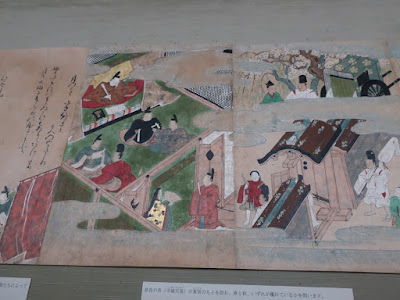Here is a “Must Go!” place for foreigners to know Japanese culture. This
is the one of the largest museums and it has 89 designated national treasures
which account for 10% of all. Moreover, it has 644 designated important
cultural properties.
Therefore, you can see high-end art crafts here which will help you to know Japanese culture. There are not so many exhibits about ordinary people, however it's worth going.
日本の国宝の10%を保存する東京国立博物館。さすがに、庶民的な展示品が少ないが、ハイエンドの品々を見学できる。ここに来れば、日本の美術、工芸はすべて分かる。重要文化財もゴロゴロある。圧巻。
Therefore, you can see high-end art crafts here which will help you to know Japanese culture. There are not so many exhibits about ordinary people, however it's worth going.
日本の国宝の10%を保存する東京国立博物館。さすがに、庶民的な展示品が少ないが、ハイエンドの品々を見学できる。ここに来れば、日本の美術、工芸はすべて分かる。重要文化財もゴロゴロある。圧巻。
昭和13年に開館した立派な建物。徳川将軍が帰依した寛永寺の御坊があった場所に建てられた。
Entrance、さすが国立博物館のエントランス
Lacquerware、漆工
The technique “maki-e” have been developed in Japan. Sprinkled metallic powder such as gold on the lacquer surface are excellent.
日本で独自の発展を遂げた蒔絵は、黒の地に華やかな金などの金属の粉が映える。
Mirror box (15th century, Important cultural property)、蒔絵鏡箱(室町時代、重要文化財)
Metalwork、金属工芸
It is written, “Japan learned from the techniques and products of China and Korea.” Swords and armor, and ritual implements are exhibited.
中国、韓国の影響を受けながら成熟してきた。武具、宗教用具などが展示されている。
Long sword by Tomonari (11th to 12th century. National treasure): Japanese swords are typical metalworks、金属といえば、刀。まずは、国宝の太刀、古備前友成
Long sword (Tachi) by Kunitoshi, 13th century、鎌倉時代の重要文化財、二字国俊(にじくにとし)の太刀
Long sword named “Koryu Kagemitsu” (1322, National treasure)、国宝の太刀、長船景光、倶利伽羅龍の浮彫があり「小龍景光」の号を持つ
”Koryu(small dragon) is carved at the end of the sword. 小龍景光の茎(なかご)部分
Flower garland (13th century, Important cultural property)、金銅蓮華文華鬘(もんげまん)、鎌倉時代・重要文化財
Reliquary in the shape of a Stupa (17th
century)
金銅舎利塔(江戸時代、奈良・薬師寺)
Ceramics、陶磁
Bohemian style ceramics have been made since 16th century in order to use tea ceremonies. Various creative ceramics have been made since the Edo period (1603~1868).
16世紀以降、茶人達の求めに応じ、自由奔放な意匠の陶器が作られた。江戸時代以降は、工夫が凝らされてきたとあるが、私は、なんとなく、志野焼が好み。
Food cups with flowering plants (16th – 17th century, Shino-ware)、志野草文向付(くさもんむこうづけ)
Tea bowl named “Furisode" (swinging sleeves of kimono, 16th to 17th century, Shino-ware)、志野茶碗 振袖
Fan shapes food cups (17th century,
Oribe-ware)
織部扇形向付(むこうづけ)
Artifact、工芸品
The photos below are boxes for the shell-matching game with scenes
from “Genji” (17th century). Those were marriage gifts of daimyo
lord’s daughters. The amazing fact is that the noble ladies bet beautiful picture
rolls on the game. (Kiyu-Shouran(Part 1))
大名家の婚礼で重要な役目を担った貝桶。源氏絵彩貝桶。絵巻物を賭けて遊んでいたと言うから(嬉遊笑覧 (Part 1))驚きだ。
Wooden pillows for a daimyo (19th century) which were also marriage gifts、やはり大名家の婚礼で用いられた祝いの枕
Box for ten kinds of incense (19th century). Ladies enjoy a game “in which participants tried to identify incense woods by their aromas.”、組香に用いる花鳥蒔絵十種香箱。素敵な品だ。
Calligraphic works and paintings、書画
Paintings on the folding screens and sliding doors (16th to 19th century)、安土桃山~江戸時代の屏風と掛軸の展示も立派
Copy of the sutras donated by Heike Clan (Historical record): both of pictures and letters are excellent、平家納経の模本(19世紀)絵も字も美しい(史料)。
Illustrated scroll of the story about a poetry content (15th century)、たけくらべ草子(室町時代)
Ukiyo-e printings、浮世絵
Dance of autumn leaves by Harunobu Suzuki; I visited in autumn, so autumn themed Ukiyo-e were exhibited.
鈴木春信の紅葉舞。紅葉の舞い散る中、両手に傘を持って舞う。訪問時期の秋の絵が展示されている。
The maple trees at Mama Tekona Shrine by Hiroshige (1867) : Yoshinofamily, whose diary is introduced in this blog, visited there often.
主人の日記を本ブログの記事にしている吉野家も良く訪れた手古那の社。筑波山とともに広重が描いている。
Ebisu-kou (18th century): it was a religious event, although people enjoyed it. 恵比須講(鳥高斎栄昌)
Viewing autumn leaves at Kaianji tempe (18th century)、海晏寺(かいあんじ、当時は東京近郊の品川にある)の紅葉狩り 勝川春潮
Courtesans (19th century)、遊女達(三枚組)
Ainu area、アイヌのコーナー
Okinawa area、沖縄のコーナー
Asian Gallery、東洋館
Asian art such as Chinese ceramics are
exhibited.
中国の陶器などが展示されている
Special viewing of Takamikura (The
Imperial Throne) and Michoudai(August Seat of the Empress)
高御座と御帳台の特別公開
高御座と御帳台の特別公開
New Emperor proclaimed his accession to
the throne to Japan and overseas in last October, 2019. Charles (Prince of Wales) attended
at the ceremony called “Sokuirei-Seiden-no-gi”, too.
He ascended the Imperial Throne (Takamikura) and delivered the address. The Empress ascended the August Seat (Michodai) at the same time.
They wore traditional costume, especially the emperor wore Kourozen-no-gohou 黄櫨染御袍 which only the emperor can wear since Heian-era (794-1185). We could see the seats and ceremonial items at Tokyo National Museum. Admission fee was free. I visited in January, 2020.
He ascended the Imperial Throne (Takamikura) and delivered the address. The Empress ascended the August Seat (Michodai) at the same time.
They wore traditional costume, especially the emperor wore Kourozen-no-gohou 黄櫨染御袍 which only the emperor can wear since Heian-era (794-1185). We could see the seats and ceremonial items at Tokyo National Museum. Admission fee was free. I visited in January, 2020.
天皇陛下が内外に即位を正式に宣明された即位礼正殿の儀(2019年10月22日)で、天皇陛下が昇った高御座と皇后陛下が昇った御帳台、そして儀式で用いられた威儀物が東京国立博物館で公開された(2020年1月に訪問)。
京都御所でも公開が予定されている。一見の価値、十分にあり。
Throne in the Takamikura; the finish of lacquering
and metal ornaments are excellent! 高御座の中の御椅子(ごいし)、漆や装飾の仕上げが素晴らしい。
|
Same article is uploaded on the site bellow with the temporary
building for enthronement “Daijokyu” and the museum in the Imperial Palace
which was the Edo castle.
LINK: The Museum of the Imperial Collections, Sannomaru Shouzokan and Imperial Palace、宮内庁三の丸尚蔵館と皇居
同じ記事を、大嘗宮一般公開、三の丸尚蔵館の写真と共に上記リンクにアップロードしています。LINK: The Museum of the Imperial Collections, Sannomaru Shouzokan and Imperial Palace、宮内庁三の丸尚蔵館と皇居
Visited in November, 2019
Website: https://www.tnm.jp/?lang=en, accessed in April, 2020
Previous post (Entertainment encyclopedia in the Edo period、江戸時代の娯楽の百科事典):
Kiyu-Shouran、嬉遊笑覧 (Part 8/Final)
Next post (Another national museum in Tokyo):
The National Museum of Nature and Science 国立科学博物館




































Comments
Post a Comment